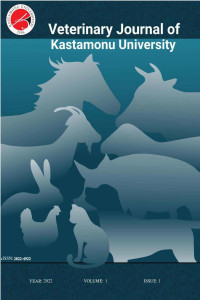Case Report
Clinical, radiographic, ultrasonographic diagnosis, and treatment of urolithiasis in two domestic cats - case report
Abstract
In this case report, clinical, radiographic, and ultrasonographic diagnosis, and operative treatment of uroliths encountered in the urinary bladder of two domestic cats were shared. In the radiographic and ultrasonographic examinations of both cats brought with complaints of intermittent urination, uroliths were detected in their urinary bladders. After the uroliths were removed by cystotomy operation, it was determined that both cats were followed for six months and were in good health and no recurrence was observed.
Keywords
References
- Albasan, H., Osborne, C.A., Lulich, J.P., & Sancak, A.A. (2013). Köpek ve kedilerde ürolitiazis. Türkiye Klinikleri Journal Veterinary Sciences, 4(2), 39-52.
- Aké-Chiñas, M.A., Mendoza-López, C.I., Del-Angel-Caraza, J., Quijano-Hernández, I.A., Rodríguez-Alarcón, C.A., & Barbosa-Mireles, M.A. (2022). Canine struvite urolithiasis: Epidemiological and clinical characteristics in Mexico. Journal MVZ Cordoba, 27(1), 1-10. https://doi.org/10.21897/rmvz.2338
- Grauer, G.F. (1993). Medical treatment of canine uroliths. In: D. Slatter (Ed.), Textbook of Small Animal Surgery (1st ed., pp. 1488-1495). W.B. Saunders Company, Philadelphia.
- Houston, D.M., & Moore, A.P.E. (2009). Canine and feline urolithiasis: Examination of over 50 000 urolith submissions to the Canadian Veterinary Urolith Centre from 1998 to 2008. Canadian Veterinary Journal, 50(12), 1263–1268.
- Koehler, L.A., Osborne, C.A., Buettner, M.T., Lulich, J.P., & Behnke, R. (2008). Canine uroliths: frequently asked questions and their answers. Veterinary Clinical Small Animal, 39(1), 161–181. https://doi.org/10.1016/j.cvsm.2008.09.007
- Kopecny, L., Palm, C.A., Segev, G., & Westropp, J.L. (2021). Urolithiasis in dogs: evaluation of trends in urolith composition and risk factors (2006-2018). Journal Veterinary Internal Medicine, 35, 1406–1415. https://doi.org/10.1111/jvim.16114
- Küçük, O. (2020). Pratik kedi ve köpek besleme-beslenme hastalıkları (1st ed.). Verda Yayıncılık.
- Langston, C., Gisselman, K., Palma, D., & McCue, J. (2008). Diagnosis of ürolithiasis. conpendium on continuing education for veterinarians. Compendium, 30(8), 447-454.
- Lulich, J.P., Osborne, C.A., Bartges, J.W., & Lekcharoensuk, C. (2000). Canine lower urinary tract disorders. In: S. J. Ettinger, & E. C. Feldman (Eds.), Textbook of Veterinary Internal Medicine (5th ed., pp. 1747-1781). W.B. Saunders Company, Philadelphia.
- Osborne, C.A., Kruger, J.M., Lulich, J.P., Polzin, D.J., & Lekcharoensuk, C. (2000). Feline lower urinary tract disorders. In: S. J. Ettinger, & E. C. Feldman (Eds.), Textbook of Veterinary Internal Medicine (5th ed., pp. 1710-1747). W.B. Saunders Company, Philadelphia.
- Rinkardt, N.E., & Houston, D.M. (2004). Dissolution of infection-induced struvite bladder stones by using a noncalculolytic diet and antibiotic therapy. Canadian Veterinary Journal, 45, 838–840.
- Rizzi, T.E. (2014). Urinalysis in companion animals part 2: evaluation of urine chemistry & sediment. Today’s Veterinary Practice, 86-91.
- Sancak, I.G., Özgencil, F.E., & Sancak, A.A. (2009). Fakülte kliniklerine gelen (2002-2003) kedi ve köpeklerde ürolitiazis olgularının klinik değerlendirilmesi. Ankara Üniversitesi Veteriner Fakültesi Dergisi, 56, 105-111.
- Tion, M.T., Dvorska, J., & Saganuwan, S.A. (2015). A review on urolithiasis in dogs and cats. Bulgarian Journal of Veterinary Medicine, 18(1), 1-18, https://doi.org/10.15547/bjvm.806
- Tiruneh, D., & Abdisa, T. (2017). Review on canine urolithiasis. American Research Journal of Veterinary Medicine, 1(1), 1-7.
There are 15 citations in total.
Details
| Primary Language | English |
|---|---|
| Subjects | Veterinary Surgery |
| Journal Section | Case Reports |
| Authors | |
| Publication Date | June 30, 2022 |
| Submission Date | May 11, 2022 |
| Published in Issue | Year 2022 Volume: 1 Issue: 1 |


